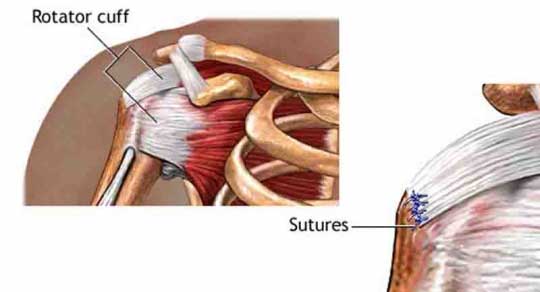Why would I have a rotator cuff operation?
Surgical rotator cuff repair can provide considerable reduction in symptoms and disability, allowing you to return to normal activity, work or sport.
It is important to remember that a rotator cuff repair is not guaranteed to ‘fix everything’.
In a large majority of cases, rotator cuff injuries, including tears, can be managed without an operation. There is a lot of evidence that, through Physiotherapy and rehabilitation, you can have the same successful outcome as with an operation, without the risks associated. Often, it will be recommended that at least 3 months of conservative treatment is undertaken before considering surgery.
You should ensure that you are fully informed about the pros and cons of surgery, and expected outcomes before agreeing, keeping in mind these will vary depending on factors specific to yourself and your injury.
What is involved?
The method of repair will be dependent on your individual situation, and determined by your surgeon.
It may be open (incision over the shoulder and detachment of the deltoid to allow access to the rotator cuff), or arthroscopic (keyhole).
What would pre-op Physiotherapy look like?
Evidence shows better outcomes from rotator cuff surgery for those with more range of motion, and higher general physical activity levels before the operation. See our blog post about Physiotherapy before and after an operation here
We will:
- Give you tools to achieve as much movement as possible before your operation
- Provide manual therapy to help increase range of motion and manage pain.
- Give advice about how you can maintain or increase your physical activity levels for general health and fitness, despite your shoulder symptoms.
What will post-op Physiotherapy look like?
Specific guidelines can vary depending on the surgeon, as well as the specifics of your injury and operation.
To allow optimal healing and promote long-term benefit from the operation, rehabilitation is gradual and must follow certain progressions.
Here’s an indication of what to expect at Back In Action:
0-2 weeks
- We want minimal strain on the repair site at this stage – sling on at all times
- Pain management
- Explanation of safe ways to go about daily tasks
- Passive movements of the arm – this is where your shoulder is moving but the arm itself is not doing the work.
- Manual therapy might be useful to reduce tightness in muscles away from the operation site e.g. the neck and the front of the shoulder / chest region
2-6 weeks
- We will give you an exercise programme to increase range of motion at the shoulder
- In this phase, all movements you will assist with your uninjured arm, or a household item
- Advice on which specific movements to continue to avoid
- Possibly weaning of the sling towards the end of this phase
6-12 weeks
- We will adapt your exercises programme to focus on active movement of the shoulder
- It’s safe for the operated shoulder to start to move on it’s own now
- You can start getting back to normal activity around the house and workplace
- You’ll get advice on how to do this, whilst avoiding ‘overdoing’ it
12 weeks+
- Time to add load/resistance to your exercises
- We’ll prescribe a programme using equipment and your own bodyweight to increase the strength and activity tolerance of the shoulder
- This could include gym work
- Functional training – we’ll include specific movements, exercise and advice for your job and/or activity of choice

